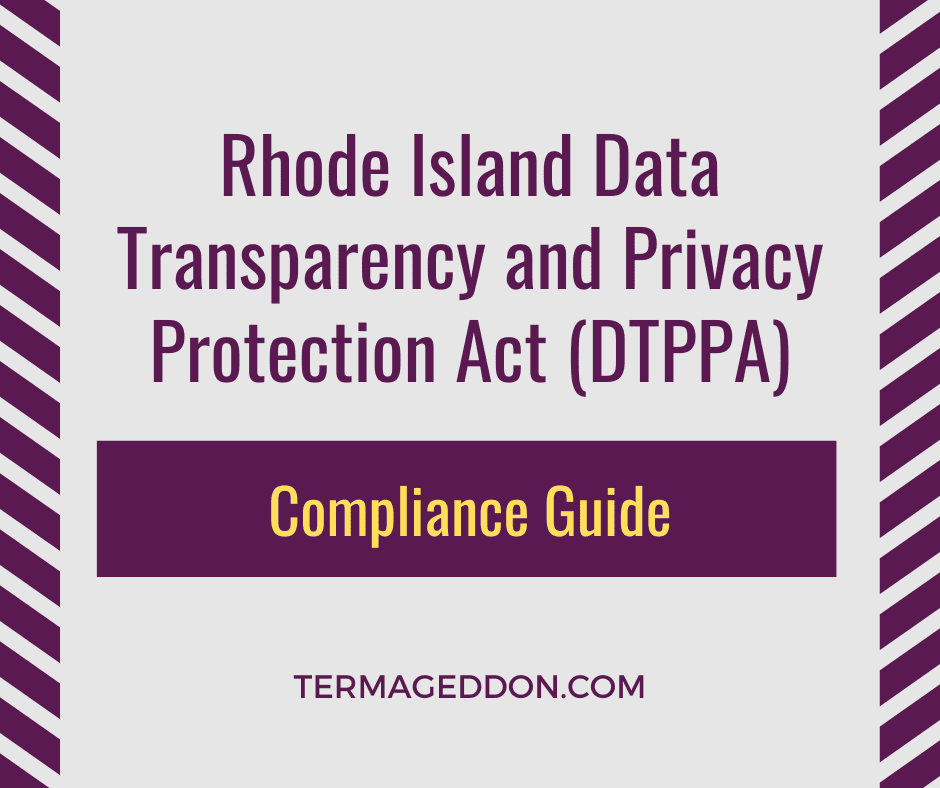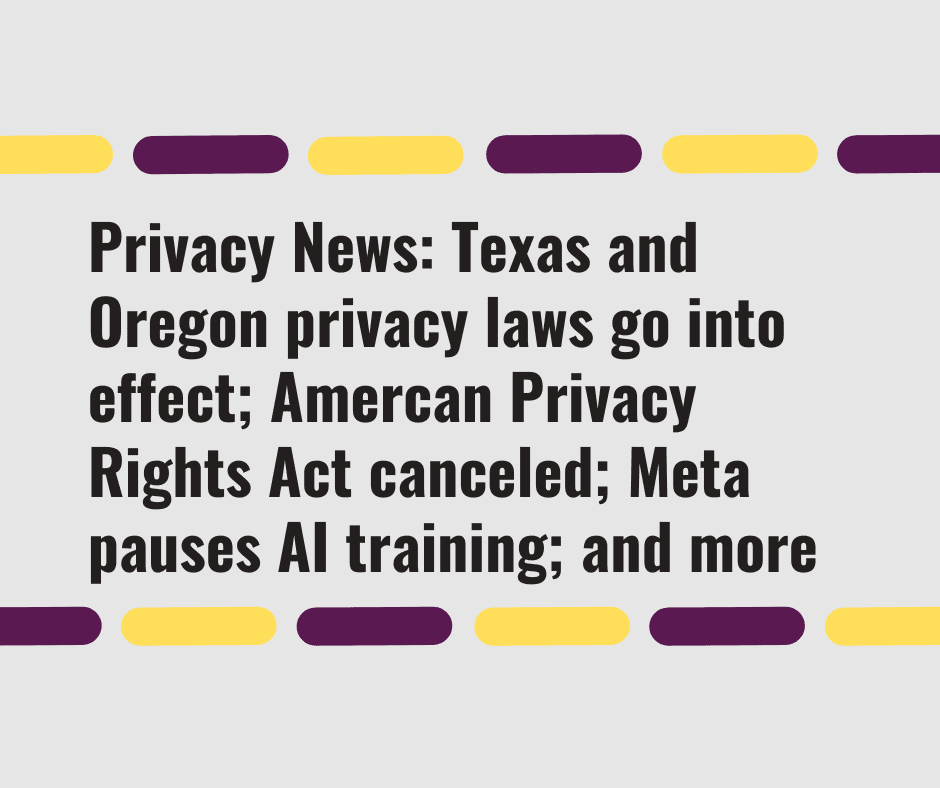What does it take to have a privacy-focused website?
If you ask the average web designer they’ll likely tell you it’s just a matter of not selling people’s data illegally or signing people up for emails they didn’t subscribe to. While these are certainly good practices, there are far more aspects to consider to ensure your website prioritizes privacy.
As a web agency owner before working at Termageddon, the more I learned about privacy, the more I was surprised just how many features can violate people’s privacy if not used properly.
Table of Contents
Why is it important to have a privacy-focused website?
First and foremost, why should you care?
Really for two main reasons: 1) It’s the law and 2) It can be a massive competitive advantage.
1) It’s the law – people’s online privacy is still a relatively new concept for most lawmakers. The General Data Protection Regulation (GDPR) went into effect in 2018 and more or less set the standard across the globe for what people’s privacy rights should look like online. Since then, new privacy laws have been passed each year that mimic or even expand-upon protection for people’s online privacy and data.
Failing to comply with these laws can lead to hefty penalties for the website owner. These start at $2,500 per website user who visited your website and had their rights infringed upon. While these laws used to be limited to mostly large corporations, lately more and more privacy laws have started targeting smaller businesses/websites.
2) It’s a competitive advantage – With privacy still being somewhat new, web agencies that have a strong grasp on creating privacy-focused websites will have an advantage over their competition.
Consumers care more about their online privacy than ever before with 64% of Americans saying websites aren’t doing enough to protect their data, according to a study by KPMG. So, websites that can alleviate privacy concerns will have yet another pitch to offer possible customers who not only want to look good to their users, but also avoid the fines and lawsuits mentioned above.
The basics of a privacy-focused website: the 7 foundational principles
A privacy-focused website will follow GDPR’s outline for privacy by design. This is characterized by seven foundational principles, which provide additional information on how this concept is implemented into practice. These principles are as follows:
- Proactive, not reactive. Preventative, not remedial. You must anticipate and prevent privacy incidents before they happen;
- Privacy as the default setting. If an individual does not take any action, their privacy must still be preserved by default;
- Privacy embedded by design. Privacy features should not be an add-on; privacy must be an essential component of the core functionality being delivered;
- Full functionality – positive-sum, not zero-sum. Privacy should not be a trade-off and it is possible to have both privacy and security;
- End-to-end security – full lifecycle protection. Privacy by design extends security throughout the entire lifecycle of the PII, ensuring that strong security measures as implemented from start to finish;
- Visibility and transparency. All of the component parts of a business practice or technology must remain visible and transparent to users and providers; and
- Respect for user privacy – keep it user-centric. You should respect users by offering them measures such as strong privacy defaults, appropriate notice (aka Privacy Policy), and empowering user-friendly privacy options.
The 9 features of a privacy-focused website
A website that is truly at the forefront of privacy will prioritize each of these nine features:
- Data minimization
- Tracking minimization
- Obtaining consent on forms
- Obtaining consent for tracking
- Having a compliant Privacy Policy
- Providing visible privacy information
- Vendor management
- Security
- Data retention
1. Data minimization
Privacy-focused websites should never collect data for the sake of collecting data. Only collect data that is needed now for a clear and specific purpose.
Don’t fall into the trap of saying “maybe we’ll use this in the future.” The easiest way to protect the information of your website users is to avoid collecting their information to start with.
Example: Your website has a contact form that collects names, phone numbers, and email addresses. However, you only respond via email communications. It’s good privacy practice to acknowledge this and remove ‘Phone Number’ from the form.
2. Tracking minimization
This is similar to data minimization but refers to tracking software like Google Analytics and Meta Pixels that track your users’ data and actions on your website. If you’re not actively using these tools, be sure to remove them from your website so that you’re not sharing user data with these third-parties (Google, Facebook, etc.) for no reason.
Even if you do plan on using tracking technologies to improve your website, try to find more privacy-focused alternatives. For example, Google Analytics has been found in the past to not comply with privacy laws like GDPR. That’s why tools like Fathom Analytics have started appearing to provide websites with a way to still collect tracking information, but via more privacy-friendly companies.
Here are other common features we see on websites that could involve 3rd party tracking:
Don’t use IP Address Intelligence services – If customers want to inquire, they’ll inquire. Try to avoid services that look up site visitor IP addresses who provide you with their contact information. If you need to use this tool, ensure you get consent first from site visitors.
Store fonts locally – using Google Fonts? Download the font and store it locally. This not only avoids you needing to get consent to load custom fonts, but technically your website should load faster too. Not to mention, Google Fonts was deemed non-compliant with GDPR in 2022 when not stored locally.
Load videos locally – instead of embedding YouTube or Vimeo videos, load videos locally.
Try privacy-focused analytics alternatives – Instead of Google Analytics 4, try using UseFathom.com or Matomo Analytics.
Avoid embedded maps – Google Maps is another third-party script that loads maps. It’s a great experience, but technically it’s a third party. Perhaps you can list just an address or provide a map screenshot or a Google Maps link as a privacy-focused alternative.
Alternative to reCaptcha – Try using Friendly Captcha or another privacy-focused captcha alternative.
3. Obtaining consent on forms
When forms are collecting PII (e.g. contact form, email newsletter subscription form, account sign-up form), users should be required to provide consent by clicking on a box to agree to your Privacy Policy. The box should not be pre-checked and should include a link to your Privacy Policy so that users can read it before consenting.
4. Obtaining consent for tracking
If you are tracking website visitors and the privacy laws that apply to you require you to have a cookie consent banner, make sure that you have the right cookie consent banner on your website. There are several signs a cookie consent banner doesn’t comply with modern laws. A few of the more notable ones are:
- No ‘deny’ option
- Pre-ticked boxes
- Deceptive colors/word choices
- Accept all, instead of individual cookies
- No withdraw icon
- Placebo banners that don’t actually impact cookieS
If you’re not sure where to find a proper Cookie Consent Solution, Termageddon has partnered with Usercentrics to offer options that are actually privacy-focused.
5. Don’t copy policies
A Privacy Policy must always be unique to a website. The disclosures it contains will completely depend on what privacy laws apply to the business and what the website does in terms of data collection, data storage, data sharing, data selling (if applicable), and data deletion.
Even a close competitor should have a Privacy Policy with very different disclosures than your own. Similar to above, Termageddon has a Privacy Policy Generator that gets to know your businesses, what laws apply to it, and therefore what disclosures need to be made. Plus, we automatically update all our customer policies as laws change, so they never become outdated.
6. Providing visible privacy information
Ensure privacy aspects of your website are clearly visible for users to see and access. This includes:
- Place your Privacy Policy clearly in the footer of your website (not behind ‘legal’ or hidden amongst dozens of other hyperlinks)
- Ensure an ‘unsubscribe’ option is clearly visible for all emails you send
- Make it easy for individuals to withdraw their consent via cookie banners or email preferences
- Make sure your website has details on how users can exercise their privacy rights
- Avoid privacy dark patterns designed to mislead or confuse users into giving up their information
7. Management of vendors
It is extremely common for websites to share PII. For example, if a user submits a contact form, a copy of that form and their PII will be stored in your website’s backend. If you send email marketing, you will usually share PII with the email marketing vendor (e.g. MailChimp or ConstantContact). While this is an inevitable part of having a website, you need to make sure that you are choosing vendors that take privacy seriously and that comply with the laws that you need to comply with. Ensure that your vendors protect privacy by performing due diligence checks and asking questions such as:
- Has the vendor ever been sued or fined for privacy law violations?
- Has the company been subject to a data breach?
- Does the company have a compliant Privacy Policy?
- Does the company explain what PII they will receive from your website and how they will use/share that PII (request a Data Processing Agreement)?
- What are the security measures that the company will use.
8. Security
A privacy-focused website will ensure that a website is secure by adopting reasonable security measures such as having an SSL certificate, training employees on security and privacy, updating plugins and other software, and installing intrusion prevention and detection systems.
9. Data retention
A privacy-focused website will retain data for only as long as it is needed for a specific purpose. For example, an individual who is not a customer signs up for your email marketing list and then unsubscribes. This customer’s PII should be deleted as you no longer need it. Unneeded PII should be deleted periodically and data retention schedules should be set where, if possible, PII is deleted automatically as well.
If you’ve made it this far, thanks for reading, and congrats on being one of the web designers ahead of the game when it comes to implementing privacy onto your websites.
If you’d like another privacy-focused business to help you out with website policies, feel free to check out Termageddon.com. Our Agency Partner program lets you use our product for free on your own website before recommending it to your clients as well.
Hope this helps!




